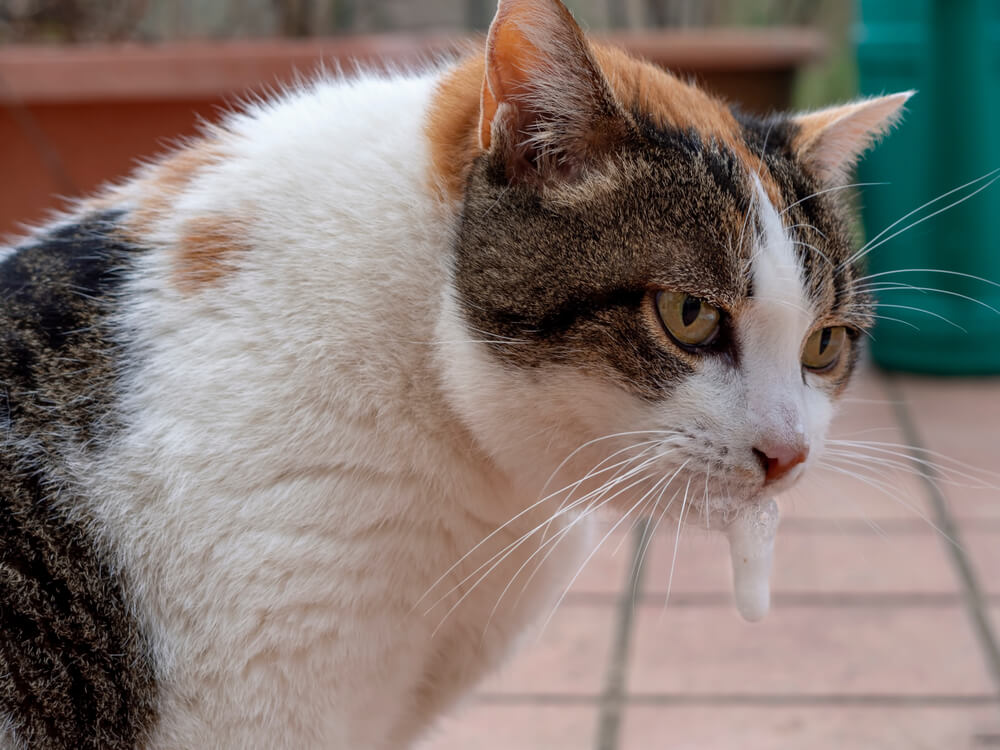The white foam that cats vomit is usually just mucus mixed with a little fluid. Mucus and fluid are almost always present in cat vomit, but they’re easy to miss when they’re mixed with food or other materials. White foamy cat vomit is most apparent when a cat throws up on an empty stomach.
There are four things you can do if your cat is throwing up white foam:
- Feed your cat more frequently
- Try a different food
- Hairball medicines
- Talk to your vet
In This Article
What Causes Cats to Throw Up White Foam
Cats can throw up white foam for many different reasons including:
- Hairballs
- Eating a new food or something unusual
- Intestinal parasites
- Inflammatory bowel disease
- Motion sickness
- Swallowing something that can’t be digested like string or bones
- Viral, bacterial, or fungal infections
- Kidney disease
- Liver failure
- Heartworm disease
- Pancreatitis
- Hyperthyroidism
- Diabetes
- Food allergies and other adverse food reactions
- Exposure to some types of toxins
- Drug side effects
- Cancer
- and more
Some of these health problems are very serious, but others can resolve with a little treatment at home.
Home Treatments for Cats Throwing Up White Foam
If your cat has just vomited once or twice but seems to feel fine otherwise, you can try some home treatment.
1. Feed Your Cat More Frequently
Cats who vomit on an empty stomach may simply need to eat more frequently. Leaving food out all the time is one option, but this can lead to unhealthy weight gain. Feeding multiple small meals is a better option, but the schedule can be hard to maintain if you’re busy, out of the house, or asleep. An automatic pet feeder will let your cat eat multiple small meals overnight or when you’re not home.
2. Try a Different Food
Cats can have adverse reactions to different ingredients in food. Switching to a different diet may help when a cat is vomiting. Wet cat foods tend to be the best choice because, in comparison to kibble, they are usually higher in protein and lower in carbohydrates, which is a better match for a cat’s nutritional needs. Wet cat foods also contain more water and fewer (or no) artificial preservatives than dry foods.
You can even start with an easy-to-digest food like Royal Canin Feline Care Nutrition Digest Sensitive. Once your cat’s vomiting has stopped, slowly switch back to their regular food by mixing increasing amounts of their regular food in with decreasing amounts of the easy-to-digest food. If you have to feed dry cat food, look for a high-quality, high-protein option like ORIJEN® Dry Original Cat Food Premium.
3. Hairball Medicines
Hairballs are a common reason for cats to vomit. It often takes several attempts to bring up a hairball, and during those first few episodes, cats may just throw up white foam.
There are many different types of hairball remedies on the market, but veterinarians frequently recommend Laxatone, a flavored hairball control gel. Never give your cat mineral oil, butter, lard, grease, or vegetable oils as a home treatment for hairballs. At best, they won’t work. At worst, they can make your cat very sick. Brushing your cat more frequently and feeding a hairball prevention diet like Hill’s Science Diet Adult Hairball Control Canned Cat Food can help too.
Talk to your veterinarian if your cat vomits hairballs more than a couple of times a month. Frequent hairballs can be caused by diseases affecting the digestive tract or skin.
4. What If Home Remedies for a Cat Throwing Up White Foam Don’t Work? Talk to Your Vet
Talk to your veterinarian if your cat continues to vomit white foam for more than a day or two or if their condition worsens at any time.
The doctor will need to figure out the cause of your cat’s vomiting, or at least rule out some of the more serious ones, before they can recommend good options for treatment. First, they will ask you a lot of questions about your cat’s health, lifestyle, and environment; perform a physical examination; and then possibly run some diagnostic tests like a fecal exam, a panel of blood work, and a urinalysis. Depending on the results of these initial tests, they might also recommend x-rays, ultrasound exams, endoscopy, surgery, and tissue biopsies, particularly if your cat appears to be very sick.
Whenever possible, treatment for cat vomiting will focus on the cat’s underlying health problem. For example, cats with intestinal parasites will need to be given medications to help them eliminate those parasites. Sometimes symptomatic care is also required when a cat is throwing up white foam, and this can include therapeutic diets, anti-nausea medications, and fluid therapy.
Don’t wait too long to get your cat the care they need. In the end, early diagnosis and treatment are almost always more successful and less expensive than delaying a trip to a veterinarian’s office.
Additional Resources On Cat Vomiting
If you’re looking for more information about your cat vomiting, this is a good video overview from Dr. Sarah Wooten on cat vomiting:
You can also check out these sources:
- Mayo Clinic Staff. (2017). Gastrointestinal disorders in cats: Common causes and treatments. Retrieved from https://www.mayoclinic.org/diseases-conditions/gi-disorders-in-cats/symptoms-causes/syc-20354649
- WebMD Veterinary Reference from the ASPCA. (2017). Vomiting in Cats. Retrieved from https://pets.webmd.com/vomiting-cats#1
- VCA Hospitals. (n.d.). Vomiting in Cats. Retrieved from https://vcahospitals.com/know-your-pet/vomiting-in-cats
And finally we’ve created a series of posts here on Pet News Daily related to gastro intestinal issues for cats and cat health in general, including:
- Home remedies that will settle your cat’s stomach
- Home remedies for cat vomiting
- What to do when your cat is throwing up food?
- What to do if there’s blood in your cat’s stool
- What to do if your cat is vomiting bile
- What to do if your cat is vomiting blood
- Over the counter medicine for cat diarrhea
- Cat foaming at the mouth: reasons & what to do
- Home remedies for cat diarrhea


